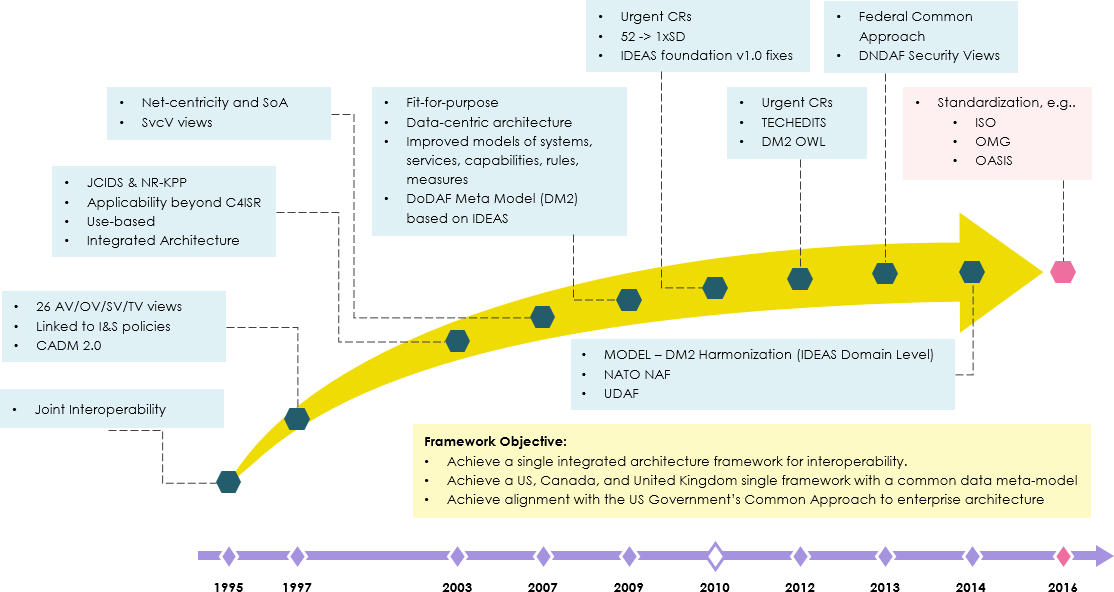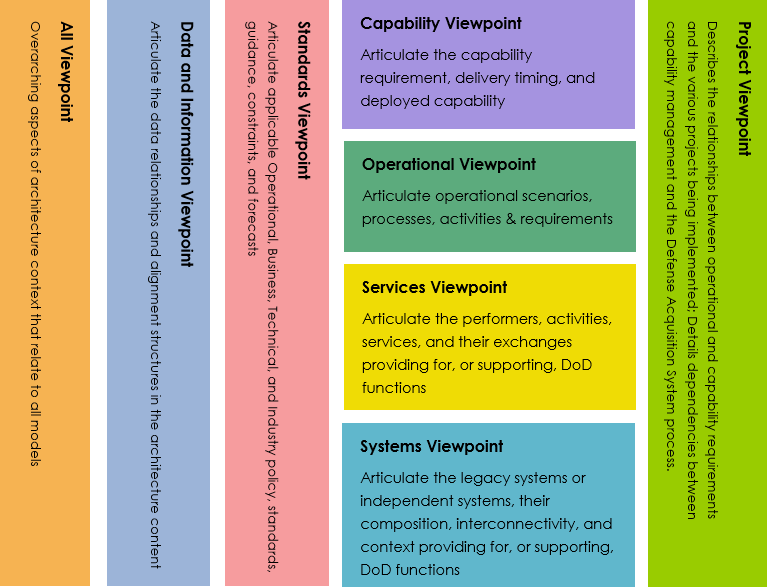Czym jest DoDAF?
DoDAF jest ramą architektury systemów opracowaną przez amerykańskiego podsekretarza obrony dla grupy roboczej ds. transformacji biznesowej Departamentu Obrony USA.
DoD to skrót od Departamentu Obrony USA. Poprzednikiem DoDAF jest ramy architektury C4ISR. C4ISR to termin wojskowy oznaczający zautomatyzowany system dowodzenia. Jest to skrót od pierwszych liter angielskich słów dla siedmiu podsystemów w nowoczesnym systemie dowodzenia wojskowego, a mianowicie: Dowodzenie, Kontrola, Łączność, Komputery, Wywiad, Nadzór i Rozpoznanie. Mówiąc prosto, C4ISR to zautomatyzowany system dowodzenia wojskowego opracowany przez amerykańskie siły zbrojne.
Ewolucja ram DoDAF

- C4ISR AF 1.0 został wprowadzony w czerwcu 1996 roku.
- C4ISR AF 2.0 został wydany w grudniu 1997 roku.
- DoDAF 1.0 został wydany w sierpniu 2003 roku, aby zwiększyć zakres jego zastosowania, nie ograniczając się do C4ISR, ale mogąc być stosowanym we wszystkich obszarach misji; wydano również CADM v1.01 (Model Danych Architektury Rdzeniowej).
- W kwietniu 2007 roku wydano DoDAF 1.5, ze szczególnym naciskiem na koncepcję Net-Centric, a koncepcja Net-Centric została odzwierciedlona w opisie architektury; wydano również CADM v1.5, aby przechowywać plik opisu nowej koncepcji Net-Centric.
- DoDAF 2.0 został wydany 28 maja 2009 roku.
W porównaniu do poprzednich wersji, główne zmiany w wersji 2.0 są następujące.
- Proces rozwoju architektury przesunął się z podejścia skoncentrowanego na produkcie na podejście skoncentrowane na danych, głównie dostarczając dane decyzyjne.
- Trzy główne widoki (operacyjny, techniczny i systemowy) zostały przekształcone w bardziej szczegółowe widoki. Obecnie istnieje osiem widoków: widok ogólny, widok danych i informacji, widok standardowy, widok zdolności, widok operacyjny, widok usług, widok systemowy i widok projektu.
- Opisuje potrzebę dzielenia się danymi i dostępu do informacji w środowisku federalnym.
- Wyjaśniono i opisano związek z Federalną Architektura Przedsiębiorstwa.
- Utworzono metamodel ram architektury DoD.
- Opisano i omówiono metodologię rozwoju architektury zorientowanej na usługi (SOA).
Struktura ram DoDAF
Ramy DoDAF mogą być szeroko złożone z ośmiu widoków i metodologii wdrożeniowych. Osiem widoków jest następujących.

- Widok ogólny, AV: dostarcza informacji o całym opisie architektury, takich jak zakres i kontekst opisu architektury.
- Widok zdolności, CV: Opis zdolności, które są wykorzystywane do osiągnięcia celów korporacyjnych zgodnych z wizją korporacyjną.
- Widok danych i informacji, DIV: Wymagania dotyczące informacji biznesowych i ustrukturyzowane zasady procesów biznesowych używane do opisu architektury. Opisuje informacje związane z wymianą informacji w opisie architektury, takie jak atrybuty, cechy i wzajemne powiązania.
- Widok operacyjny, OV: Opisuje organizację, zadania lub działania oraz informacje, które muszą być wymieniane między nimi. Przekazuje rodzaj wymienianych informacji, częstotliwość wymiany, zadania i działania wspierane przez wymianę informacji oraz charakter wymiany informacji.
- Widok projektu, PV: Opisuje, jak plany projektów są łączone w plan portfelowy z relacją wzajemną. Ten widok zapewnia sposób opisu relacji organizacyjnych między wieloma projektami, z których każdy jest odpowiedzialny za dostarczenie jednego systemu lub funkcji.
- Widok usług, SvcV: Opisuje systemy, usługi i powiązane funkcje, które wspierają działalność operacyjną. Procesy DoD obejmują funkcje operacyjne, komercyjne, wywiadowcze i infrastrukturalne.
- Widok standardów, StdV: Jest najmniejszą kolekcją zasad, które kontrolują kombinację, interakcję i wzajemne zależności między częściami lub elementami systemu. Jego celem jest zapewnienie, że system jest w stanie spełnić określony zestaw wymagań operacyjnych. Ten widok dostarcza wskazówek dotyczących technicznej implementacji systemu, na podstawie których można tworzyć specyfikacje inżynieryjne, budować wspólne moduły i rozwijać linie produktów. Obejmuje standardy techniczne, praktyki wdrożeniowe, standardowe opcje, zasady i kryteria.
- Widok systemów, SV: Informacje o zautomatyzowanych systemach, interkoneksji i funkcjonalności systemu. W niedalekiej przyszłości ten widok zniknie, gdy DOD skupi się na środowiskach zorientowanych na usługi i chmurze obliczeniowej.
Aby zachować spójność i całość między widokami, DoDAF V2.0 definiuje 52 artefakty, aby pokazać całą architekturę od wymagań do wdrożenia. Jednak nie wszystkie artefakty są wymagane i mogą być używane w razie potrzeby.
Jak wdrożyć DoDAF?
Metodologia wdrożenia DoDAF składa się z 6 kroków.
1) Zdefiniuj zastosowanie architektury
Zdefiniuj cel i zamierzony sposób użycia architektury („dopasowane do celu”), jak będzie przeprowadzany wysiłek związany z opisem architektury, metody używane w rozwoju architektury; kategorie wymaganych danych, potencjalny wpływ na innych oraz proces mierzenia sukcesu wysiłku poprzez wydajność i satysfakcję klienta. Informacje te są zazwyczaj dostarczane przez właściciela procesu, aby wspierać rozwój architektury, który opisuje jakiś aspekt ich obszaru odpowiedzialności (proces, działalność itp.).
2) Określenie zakresu architektury
Określa granice, które ustalają głębokość i szerokość opisu architektury, ustala zestaw problemów architektury, pomaga zdefiniować jej kontekst oraz określa poziom szczegółowości wymagany dla treści architektury. Jest to również ważne dla podjęcia decyzji, jak postępować z rozwojem lub zakupem wsparcia automatyzacji.
3) Określenie wymagań dotyczących danych
Wybór jednostek danych i atrybutów jest ważny, aby architektura była budowana w sposób, który nie tylko spełnia cele pierwszego kroku, ale także utrzymuje spójność architektury. Jednostki i atrybuty są reprezentowane przez typy danych, które obejmują zasady regulujące zachowanie biznesowe, informacje o działaniach do wykonania, relacje dowodzenia, listy zadań i wiele innych typów.
4) Wykonanie projektu produktu architektury
Jest to najważniejszy krok w wprowadzaniu i edytowaniu istniejących modeli architektury, zbieraniu nowych danych i dodawaniu ich do architektury oraz wydobywaniu danych z istniejących architektur w Bazie Wiedzy Systemu DoD lub pokrewnych bazach wiedzy, a następnie organizowaniu i klasyfikowaniu wszystkich danych, rejestrowaniu ich w DARS (System Rejestru Architektury DoD) oraz powiązaniu ich z automatycznym repozytorium do późniejszej analizy i ponownego wykorzystania.
5) Analiza architektury
Na architekturze zawierającej wszystkie wymagane dane przeprowadza się analizę statyczną, dynamiczną, eksperymentalną i testową, aby określić ważność danych architektury.
6) Generowanie plików wynikowych architektury
Generuj opisy produktów architektury na podstawie podstawowych zapytań danych, które powinny być zgodne z ustalonym modelem, wielokrotnego użytku i do udostępnienia.
Wpływ DoDAF
Prawdopodobnie z wojska, DoDAF nie ma tak dużego wpływu na architekturę przedsiębiorstwa jak TOGAF. Jednak wraz z wydaniem wersji 2.0, sama rama DoDAF nadal się rozwija, nie jest już tylko stosowana do budowy systemów wojskowych, przedsiębiorstwa mogą w pełni elastycznie korzystać z DoDAF do wdrażania architektury przedsiębiorstwa. Ponadto badania nad C4ISR i DoDAF dały początek teorii „Systemu Systemów”, która jest obecnie gorącym tematem w akademickim świecie. Można powiedzieć, że DoDAF jest jednym z najcenniejszych ram badawczych w wielu ramach EA.
Oprogramowanie DoDAF – Visual Paradigm
Visual Paradigm oferuje łatwe w użyciu, oparte na modelach rozwiązanie, które wspiera rozwój widoków i modeli DoDAF 2.02. Twórz zintegrowane produkty DoDAF, które utrzymują śledzenie między widokami. Generuj dokumenty architektury, które ułatwiają organizacjom skuteczne koordynowanie inicjatyw architektury przedsiębiorstwa.
Odnośniki DoDAF
- Dowiedz się o DoDAF – Czym jest rama DoDAF?
- Narzędzie oprogramowania DoDAF – Visual Paradigm
- Jak zastosować DoDAF w swoim projekcie EA?
- Wikipedia | Ramy architektury Departamentu Obrony
- Ramy architektury DoDAF Wersja 2.02
- Potężne narzędzie oprogramowania TOGAF
Ten post dostępny jest również w Deutsch, English, فارسی, Français, Bahasa Indonesia, 日本語, Portuguese, Ру́сский, Việt Nam and 繁體中文











